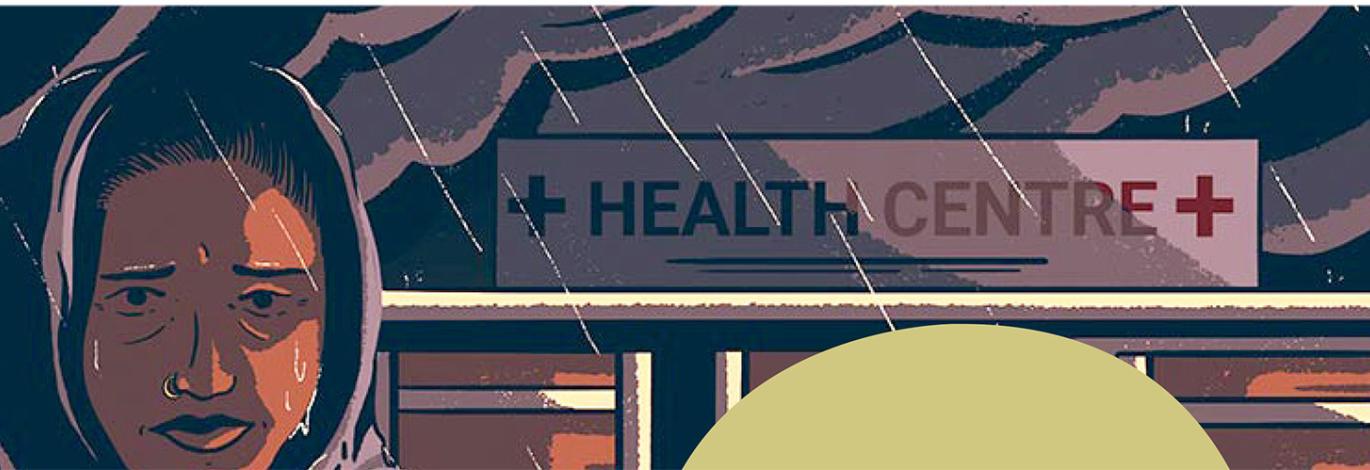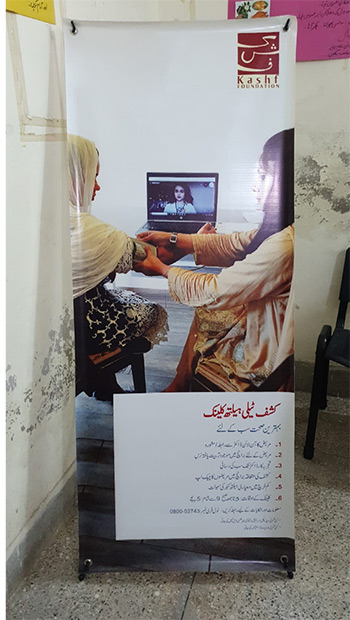
After giving birth to 9 children, 48 year old Seema Mazhar, from Matli in Badin district thought she could finally focus on creating a better life for herself and her children by running her own small cloth trade business. However, she had been feeling unwell for a few weeks and felt an extra ordinary amount of pressure in her pelvic area. Traditionally taught to ignore such pains and aches due to the scarcity of resources to deal with these issues, Seema powered by her health insurance broke the norm and sought advice from a doctor. She was diagnosed with a stage 3 uterovaginal prolapse and required a hysterectomy to relieve her of the pain and discomfort. Seema was able to afford this surgery, costing her a hefty PKR 35,000, through the Kashf Comprehensive Health Insurance which was bundled with her business-loan from Kashf Foundation. Seema would never have been able to get treatment, without the health insurance coverage. Seema is part of the over 130,000 low-income persons that have been able to use the Kashf Comprehensive Health Insurance to pay for their in-patient health procedures since the insurance was rolled out.
Across the world, low-income households have inferior health outcomes as they tend not be able to purchase items needed for good health such as enough nutritious food, vaccinations, and nutritional supplements. This is further exacerbated by other factors related to poverty, such as lower levels of hygiene and less information on practices that can promote health. According to the Population Reference Bureau, women (especially those in developing countries) suffer a health disadvantage due to the ‘biological differences’ between the sexes and gender inequality (socio-cultural values ascribing different roles to men and women). Gender inequality can be understood in three ways – resource inequality (related to income, economic opportunities, equal wage, access to education, access to skills development etc), vital inequality (access to health services, access to reproductive health services, sex ratio in the population, life expectancy by gender, control and choice in terms of number of children etc) and existential inequality (related to domination of patriarchal norms and control, power, and agency).
Patriarchy poses one of the biggest challenges for women in countries like Pakistan when it comes to access to health care – it is further combined with resource inequality as limited budgets and incomes are usually prioritised by men.
Patriarchy poses one of the biggest challenges for women in countries like Pakistan when it comes to access to health care – it is further combined with resource inequality as limited budgets and incomes are usually prioritised by men in terms of major expenditures and/ or investments. Research shows that women have little economic agency when it comes to determining the use of household resources and thus women are least likely to prioritize their own health care expenditures. And with weak social security networks, it implies delayed treatments and exacerbation of health care issues for women. It is for this reason that Pakistan is ranked 135/146 countries on the health gap when it comes to gender.
To cater to the healthcare needs of low-income households, especially women, well-designed health insurance schemes - which address issues of gendered inequities, ensure quality, provide access, are convenient to use, and have add on components for improved well-being through health camps and awareness sessions, provide the most suitable solution. Kashf Foundation through an innovative gender intentional micro-health insurance program has been able to successfully provide health insurance services to 2.1 million low-income individuals at February 2023 closing (active members).
In 2002, Kashf was the first microfinance institution to offer a credit for life insurance cover to its clients. The  rationale for introducing the product was simple enough, but Kashf had to undertake significant canvassing with insurance companies before a mutual agreement on product features and price could be reached. This product not only had positive spillovers for clients but also had a large-scale demonstration effect across the microfinance sector and today the creditfor- life product has become an industry practice. Kashf realized the need for health related products/services for its client as multiple client feedback solicitation channels from the field consistently reported that clients were unable to access healthcareservices. Research findings also showed that clients often utilized earnings from their micro-businesses towards meeting healthcare expenses which translated into a financial burden on the clients in terms of straining their repayment capacity but also stunted the growth of their micro-businesses and/or low productivity.
rationale for introducing the product was simple enough, but Kashf had to undertake significant canvassing with insurance companies before a mutual agreement on product features and price could be reached. This product not only had positive spillovers for clients but also had a large-scale demonstration effect across the microfinance sector and today the creditfor- life product has become an industry practice. Kashf realized the need for health related products/services for its client as multiple client feedback solicitation channels from the field consistently reported that clients were unable to access healthcareservices. Research findings also showed that clients often utilized earnings from their micro-businesses towards meeting healthcare expenses which translated into a financial burden on the clients in terms of straining their repayment capacity but also stunted the growth of their micro-businesses and/or low productivity.
Using a gender intentional approach, Kashf designed the health insurance program keeping the client’s needs, access, and challenges emanating from societal norms at the center, this particularly focused on including reproductive health care at the center of product design. The insurance is underwritten by a leading insurance company, whilst the product was designed by Kashf after in-depth research with clients. Research findings showed that Kashf’s clients prioritized the health-care needs of their children over their own, therefore the insurance provides in-patient coverage for each member of the client’s family.
Research also showed clients made frequent visits to the hospital for emergency care after motor accidents, therefore emergency treatment was also added to the coverage. Clients preferred a ‘pay as you go model’ for premium payment versus upfront deductions, therefore the premium payments are divided in equal monthly tranches for client ease and affordability. Since clients are cash-strapped, Kashf also convinced the insurance company to provide a cashless treatment at panel hospitals – while this is a standard feature for insurance policies, a majority of panel hospitals which tend to cater to higher income segments were not accessible to Kashf clients. To address this, Kashf worked with local private hospitals in the client’s vicinities to get empaneled on the insurance company’s roster. When Kashf started the health insurance only 85 panel hospitals mapped onto communities where Kashf clients were present, however, due to a concerted effort by Kashf, currently 361 panel hospitals are available for Kashf clients. This enables more clients to use the cash-less option. Another key product design feature is that there are no exclusions for pre-existing conditions, thereby making the coverage easier to understand.
The insurance product thus has multiple design features that make the product more gender centric, namely coverage for all family members to address issues of household level deprioritization of spending on girls and women’s health. No exclusions for pre-existing conditions address awareness gaps by making the product easy to understand and provides maternity coverage to already pregnant women. Separate per family member insurance limits instead of a total family coverage creates gender equity for access. Moreover, panel hospitals and cashless claims enhance ease of access by enabling women with worse off levels of literacy to avoid the process of filing claims.
In addition to client centricity in product design, Kashf also undertakes quick and seamless claim payments for clients through a specialized facilitation cell for the health insurance at the Head Office. Moreover, Kashf address gaps in knowledge and awareness for clients, through regular trainings and multiple interactions including the financial education trainings and social theatre performances. Free health camps for outpatient care are also carried out in the branches on a periodic basis to create awareness about preventative health and also the insurance products.
In addition to client centricity in product design, Kashf also undertakes quick and seamless claim payments for clients through a specialized facilitation cell for the health insurance at the Head Office.
At February 2023 closing, cumulatively 130,791 health claims (out of which 40% have been cashless) amounting to over PKR 2.5 billion (out of which 36% are cashless) have been paid out. An analysis of the health insurance claims processed has shown that while gender wise enrollment into the program is 50%, more than 76% of the number of claims and 77% of the total claims value have been used by women, which reflects the gender intentionality of the product. The average claim amount for females was PKR 19,667 while that for males was PKR 18,724. These are promising trends and further research has shown that for most women this was the first time they had accessed formal healthcare, which highlights the fact that often women under value their own health, and it was only after the health insurance cover that they addressed their health care issues.
While high quality public health infrastructure and sustained government spending on health are the more permanent solutions to addressing the health-care provision issues in Pakistan, low-cost health insurance provides a good bridge for low-income households to improve their access to health services. That said, with a potential estimated market of 47 million for micro-health insurance, currently only 4.6 million (57%) of the 8.2 million micro-insurance policies in the market are for health insurance. This signifies a large gap in the potential and outreach of health insurance which needs to be addressed by both private and public entities.
Roshaneh Zafar is the Founder and Managing Director of Kashf Foundation.
Zainab Saeed is the Chief Strategy Officer at Kashf Foundation.
